Orme's Lodge
Houses within 15km of this house
Displaying 67 houses.
Houses within 15km of Orme's Lodge
Displaying 67 houses.
| House name | Description | |
|---|---|---|
| Castletown | At the time of Griffith's Valuation, James Fenton was leasing the house at Castletown to George Fenton when it was valued at £10. In 1906 the property at Castletown was owned by Thomas G. Fenton and was valued at £11. It is no longer extant though traces of walls, stable yard and gate lodges are all still visible. | |
| Oatlands House | The residence of the O'Dowds of Bunnyconnellan until the sale of their estate in 1854 when it was bought by Charles Downing and leased to Henry McLoghry. At the time of Griffith's Valuation Downing held it in fee when it was valued at £10. It is labelled Bunnyconnellan Cottage on the 1st edition Ordnance Survey Map but as Oatlands House on the 25-inch edition of the 1890s. This is the name by which it is still known. The Irish Tourist Association file refers to Oaklands House owned by Mr McAndrew in which some of the old O'Dowd house was probably incorporated. The house has been restored and in 2015 was offered for sale. | |
| Glencarha | The Ordnance Survey Names Books record that the house was 'a new edifice not yet finished', the intended residence of George Fenton, an attorney of Kilglass, near Ballina, who was leasing the townland. The house was occupied by Isaac McLoghry at the time of Griffith's Valuation. Buildings are still extant at the site. | |
| Cottlestown | The Kirkwood estate was centred on Cottlestown House. The name seems to have sometimes been known as Castletown and this is how it appears on the First ed. OS sheet but documentary evidence would seem to suggest the estate was also known as Cottlestown. The Buildings of Ireland survey states that it is likely that the present house was added to an earlier, probably eighteenth century structure, which in turn replaced the fortified house on the site. On modern OS sheets the townland is known as Cottlestown. This property later became part of the Boyd estate. |

|
| Moyview | Moyview was part of the Wingfield estate but was let to other families at different times. At the time of Griffith's Valuation, it was being leased by Robert Warren and was valued at £12. There is still an occupied house at this site though McTernan notes that the original house was an eighteent-century single story thatched residence. | |
| Knockroe | Knockroe house was part of the Wingfield estate and at the time of Griffith's Valuation was valued at £12. The property is now part of a farm. The remains of the entrance gates are supported by an iron bedpost! | |
| Scurmore | In 1786 Wilson writes that Scurmore House was the seat of Mr. Nisbett. Later, in the nineteenth century it became a seat of the Wingfields. In the 1830s it is described as undergoing repairs but the family were again occupying it by 1857. The house is recorded as the property of S.L. Lewis in 1906 when it was valued at £37. McTernan states that the house was demolished in the mid twentieth century. A later house now exists at the site but the original outbuildings are still intact. | |
| Fortland | Wilson, writing in 1786 refers to "Fortland, pleasantly situated on the banks of the river Easky" as the seat of Mr. Browne. It later passed to the Jones estate. Both Leet in 1814 and Lewis in 1837 record it as a Jones property. In the mid nineteenth century it was bought by Richard Graves Brinkley who was leasing it to John Wingfield King at the time of Griffith's Valuation when it was valued at £14. It was offered for sale in the Landed Estates Court in 1874 when it was occupied by Mrs. Charlotte Lloyd, presumably a relative of Richard Brinkley's wife, Hester Lloyd. In 1906 it was the property of John L. Brinkley and was valued at £39. McTernan notes that the house was afterwards damaged by fire and partially demolished. Various buildings, including substantial remains of an estate farmyard, survive at this site. |
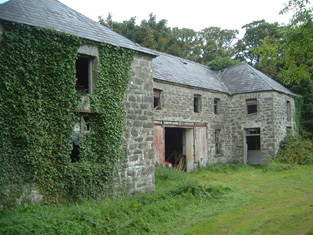
|
| Temple View | The house now known as Temple View was built in the later 19th century. At the time of Griffith's Valuation there was a building at this location owned by Peter Hale and leased to George Fenton. In 1906 Temple View was the property of James Hale and was valued at £32 as well as other buildings in the townland. McTernan states that it had a succession of owners through the twentieth century but has been vacant for long periods. In 2005 it was derelict and for sale. |
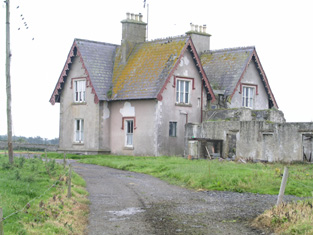
|
| Sallymount | Home of Lewis Atkinson in the early 19th century. At the time of Griffith's Valuation the house was leased by Edward Atkinson from the Wingfield estate when it was valued at £4. The site is now occupied by farm buildings. | |
| Rathlee | At the time of Griffith's Valuation Thomas Jones was leasing a property valued at £18 at Rathlee, barony of Tireragh, to John Christie. The ''Sligo Directory'' of 1862 indicates that John Christie was a magistrate for the county. McTernan states that this property was associated with the Hewitt family who were connected with the Fitzgerald family through marriage. The Fitzgeralds had acquired an interest in the property at the beginning of the nineteenth century. In 1814 Leet recorded the house at Rathlee as the residence of Michael Fitzgerald. Rathlee is no longer extant but the remains of the walled garden are still visible. | |
| Oghil | Oghil house is recorded in the OS Name Books as being built in the 1740s, though McTernan states that the existing house dates from the late 1830s. At both the time of Griffith's Valuation and in 1906 it was the property of Robert W. Armstrong and was valued at £17. It later served as the parochial house but is now a family home again. See http://www.westsligo.com/culleens/historyoghillhse.htm for more details. |

|
| Kinard Lodge | The Ordnance Survey Name Books record Kinnard Lodge as the property of the Paget family in 1837. It appears that it, like other houses in the area, was used as a summer bathing lodge. At the time of Griffith's Valuation, it was occupied by James Paget and was valued at £9. A second house in the townland was occupied by Henry Simpson, leasing from James Paget, and was valued at £6. Kinard Lodge is still extant and occupied. | |
| Dromore | At the time of Griffith's Valuation the house at Dromore was the property of John Fenton and was valued at £15. Both Leet in 1814 and Lewis in 1837 also record it as a residence of the Fenton family. In 1864 Thomas Fenton offered it for sale in the Landed Estates Court. The house was occupied at the time by Jas. McMunn, MD. In 1906 the house at Dromore was valued at £16 and was the property of William Browne Loughead. |

|
| Woodhill House | At the time of Griffith's Valuation Lewis Jones was leasing Woodhill house, valued at £25, at Knockaculleen, barony of Tireragh, from Anne Jones. When the property was offered for sale in the Landed Estates Court in May 1875 the house is described as " a handsome modern residence valued at £30". The Wingfield King estate sold their interest in the property in 1879 and the sale notice mentions Thaddeus Tiernan as occupying the house at that time. In 1906 a house here valued at £20 was the property of Thaddeus Tiernan. McTernan states that this gentleman had amassed a fortune in Australia and South America. He became involved in public life, including Board of Guardians and County Council, on taking up residence at Woodhill. The house is still owned by his descendents. |

|
| Farrenmacfarrell | James Ormsby was occupying this property at the time of Griffith's Valuation, when it was valued at £6. McTernan states that the house was built by Thomas Ormsby at the end of the eighteenth century. In 1906, the house at Farranmacfarrell was owned by Alexander Cuffe and was valued at £7. The house is still extant but appears to be unoccupied. | |
| Quignashee | Edward Howley occupied a property valued at £5 at Quignashee, barony of Tireragh, as well as 300 acres, at the time of Griffith's Valuation. Since 1898 this townland has been located in county Mayo. A building remains at the site. | |
| Rahans | The home of the Atkinson family, Wilson notes in 1786 that it was the residence of Charles Atkinson and "very pleasantly situated". It was occupied by the rector of Crossmolina, the Reverend Edwin Stock, for a few years prior to 1815. Rahans was described in 1855 as "a comfortable dwelling house, in a fair state of repair" and occupied by Mrs Frances Atkinson. At the time of Griffith's Valuation it was the home of George Orme. In 1925 Adelaide R. Orme of New South Wales sold Rahans demesne to Patrick J. Ruttledge of Ballina for £3,000, [see Acc. 1165/8/11 National Archives.] It is no longer extant. | |
| Ardnaree Rectory | At the time of Griffith's Valuation Rev. Joseph Verscoyle was occupying the house at Glebe, parish of Kilmoremoy, valued at £30. This house is no longer extant. | |
| Downhill | The house at Downhill is recorded as being built by Mr. Brennan, Merchant, Ballina. It appears, from the Ordnance Survey Name Books, that the townland of Knockalyre or Downhill was part of the Gore estate in 1836. Dr. McHugh of Ballina also had an interest in the property which he was renting to Rev. Thomas Feeney in 1857. Colonel Knox Gore also had a mill complex in this townland which, at the time of Griffith's Valuation, he was leasing to William Symes. Downhill House became a hotel when it was purchased by the Moylett family in 1936. |

|
| Ardnaree Cottage | Ardnaree Cottage dates to at least the early eighteenth century and possibly earlier. It was part of the Gore estate. Wilson, writing in 1786, refers to "Mr. Jones' charming demesne". In 1837 it was the residence of Thomas Jones and in 1857 it was leased by Col Arthur Knox Gore to Anne Hearne when it was valued at £10. The National Inventory of Architectural Heritage notes it as an important component of the domestic built heritage of Ballina. It is still extant and well-maintained. |

|
| Killala Castle | Formerly the residence of the Protestant Bishop of Killala and Achonry, it was occupied by Walter James Bourke and his wife, daughter of the Hon Frederick Cavendish founder of the ''Connaught Telegraph''. The castle was severly damaged by the 'Big Wind' in January 1839. Demolished in the 1950s. | |
| Crosspatrick | The Ordnance Survey Name Books refer to the building of a house in 1832, the residence of James Knox who held the townland from Mary Boyd. At the time of Griffith's Valuation the house was occupied by William Kirkwood. Some floor tiles, which remain in the present farmyard at Crosspatrick, indicate the site of the house which no longer exists. |
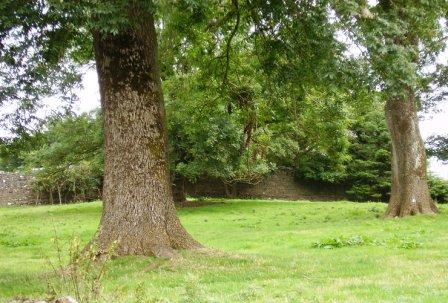
|
| Croftonpark | ||
| Ballintober | At the time of Griffith's Valuation, this property was held in fee by Nicholas Handy and valued at £8. The house is no longer extant but it was positioned behind the present house, where the red corrugated roofed building now stands. |

|
| Rosserk | Captain Green resided here in the 1830s. At the time of Griffith's Valuation, Capt Augustus Bolton was occupying a property valued at £10. On the 25-inch Ordnance Survey map of the 1890s a different building, adjacent to a large corn mill and located at G243252, is labelled Rosserk House. Buildings are still extant at this site. | |
| Croftonpark | Described in the Ordnance Survey Name Books as a 'neat house', built in 1784 and occupied by Hugh Dane [Deane]. Robert Hunter lived there at the time of Griffith's Valuation and Patrick Ruane refers to the recent death of James Hunter, the owner of the house in the early 1990s. The house is still extant but no longer in use. |
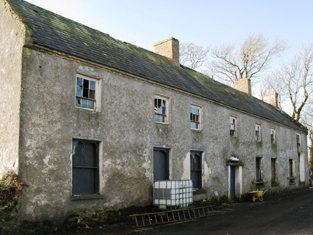
|
| Tonroe | Another Gardiner house in the parish of Rathreagh. At the time of the Ordnance Survey in the 1830s it was described as being in bad repair and occupied by a herd. P Ruane described the dilapidated state of the house in the mid 1990s but writes that the setting was very attractive. | |
| Courthill | The house was built in 1768. In 1786 Wilson refers to "Ranadyff" which may be this property, as a seat of Mr. Gardiner. At the time of Griffith's Valuation the occupier was Lacklin Chisholm. Frank Boland had a racing stable at Courthill in the 1940s and trained a horse named 'Lough Conn', who came second in the Aintree Grand National of 1947. |

|
| Springhill | Springhill was occupied by Francis Goodwin in 1814 and by Thomas Goodwin in 1837. By the time of Griffith's Valuation Bartholomew Donohoe was leasing the townland from the Palmer estate but the buildings were only valued at 10s. Springhill is labelled as "in ruins on the 25-inch map of the 1890s and there is no trace of it now. | |
| Broadlands | The home of the Knox Gore family, let to Patrick C Howley in the 1830s. It was leased by John Knox, of the Rappa Castle family, at the time of Griffith's Valuation when the house was valued at £15 10s. . A house is still extant at this site. | |
| Belleek Castle/Ballina House | Edward J Howley held Belleek Castle and demesne on a lease originally granted by James O'Hara 2nd Lord Tyrawley to Vaughan Jones for 999 years, dated 25 Mar 1739. He was residing at Belleek in the 1830s. The Castle was leased to the Pery family in the late 1860s. It is now known as Ballina House. |

|
| Beaufield House | "Bowfield" House was occupied by E. Howley in the 1830s. On both the 1st and 25-inch editions of the Ordnance Survey maps the house is labelled Beaufield House. No house of more that £1 valuation was recorded in the townland of Carrowcastle at the time of Griffith's Valuation. It is no longer extant. | |
| Bartragh House | A Kirkwood family home in the 19th century. At the time of Griffith's Valuation, the property was leased by William Hopper from the Kirkwood estate when the buildings were valued at £16. A house is still extant at the site though in a dilapidated state. |
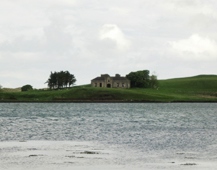
|
| Castlereagh | Described by Wilson in 1786 as "the fine seat of Mr. Knox" this house was badly damaged in 1798 and a new one subsequently built. There is a lithograph of the house included in the Encumbered Estates' Court sale rental. It was bought by Arthur E. Knox's brother Ernest Knox. In 1894 it was the residence of John V. Knox. The house has been demolished but portions of the walled garden remain. |

|
| Rappa Castle | An old Bourke castle, granted to a Cromwellian soldier named Crofton. It passed into Knox ownership through marriage and was the seat of this influential branch of the Knox family throughout the 18th and 19th centuries. In 1786 Wilson refers to it as "the pleasant seat of Mr. Knox". At the time of Griffith's Valuation it was held in fee by Annesley Knox and valued at £30. Slater notes it as the seat of Captain Annesley Knox in 1894. Occupied by the Knox family until the early 20th century, the house is now a ruin. |
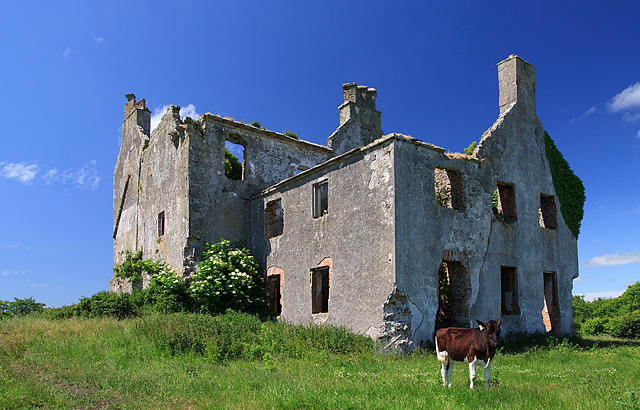
|
| Palmerstown | In 1786 Wilson had noted Palmers Town as the seat of Mr. Palmer. The original Palmer house is marked "in ruins" on the first Ordnance Survey map of the late 1830s. The Irish Tourist Association File states that it was destroyed by fire when the French forces passed by in 1798. In the mid 19th century Henry A Knox, fifth son of Annesley G Knox of Rappa, leased the townland from Sir William Palmer. Knox lived in a house converted from part of the yard buildings of the original house before the mid 1850s. His descendants continue to live there today. |

|
| Netley House | The home of Henry William Knox, fourth son of Francis Knox of Rappa, occupied by Richard Burke at the time of Griffith's Valuation when the house was valued at £30.. The house is now a ruin. |

|
| Castle Lackan | Wilson refers to Castle Lackan as" the fine seat" of Sir R. Palmer in 1786. It was occupied by James Cuff, Lord Tyrawley, early in the 19th century and later by his daughter and son-in-law, Jane and Charles Knox. It was held in fee by Colonel Charles Knox at the time of Griffith's Valuation, when it was valued at £50. It is now a ruin. |
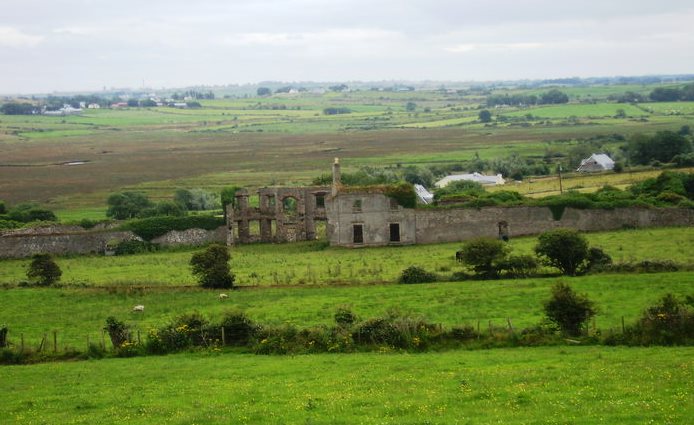
|
| Belleek Manor/Abbey | Built in 1831 in the Gothic style. The seat of Maj.-Gen Saunders Knox-Gire in 1894. It was sold in 1940 to the Beckett family who resold it to Mayo County Council. It became a santorium but now functions as the hotel known as Belleek Castle. |

|
| Moyne Abbey | Associated with the Lindsey family in the 17th century it was leased to the Knoxes by James O'Hara, Lord Tyrawley, for 999 years in 1741. The Knoxes built a private residence on to the east end of the friary. At various time the Jones, Palmer and Kirkwood families leased parts of Moyne. Thomas Jones sold his interest in the Landed Estates' Court in 1867. The Ordnance Survey Name Books record that Peter Nolan, agent to Sir William Palmer, lived in a neat cottage in the east of the townland. This may be the property labelled Moyne House on the 25-inch Ordnance Survey map of the 1890s (G228287), the remains of which are still extant. | |
| Summerhill | An 18th century house, home of the Palmer family. Wilson refers to it as the seat of Thomas Palmer in 1786. Blake records that it was leased to John Bourke at the time of the 1798 rebellion. At the time of Griffith's Valuation, it was occupied by Thomas Palmer, leasing from Ernest Knox, and valued at £15. Later sold by the Palmers to the McCormack family who owned it until the 1920s. it is now a ruin. |

|
| Fahy | Built 1796, a former Paget home occupied by Ernest Knox of the Castlereagh family in the late 1830s. Lackland Chisholm was the tenant at Fahy in 1853. The original house is no longer extant. | |
| Ballybroony | An 18th century house, occupied by Fallon in the late 1770s and in 1786. The residence of the Perkins family from the early 19th century. It was held by Arthur Perkins from the Earl of Arran at the time of Griffith's Valuation when it was valued at £17. Lived in until the early 21st century and for sale in 2006. Restoration work was underway in 2010. |

|
| Lissadrone | Described at the time of the first Ordnance Survey as a plain building ornamented with a few trees and shrubs and held on a lease for ever. In the 1850s it was occupied by Matthew Flynn and is now a ruin. | |
| Smithstown House | Ruane writes that the house was built by the Palmers and became a Royal Irish Constabulary barracks. It was the home of the Pugh family in the 1830s. The only building in the townland at the time of Griffith's Valuation, of more than £2 valuation, was the barracks. Sold in 1988 and now the home of Mrs Loretta Clarke Murray and family. |

|
| Carrowmore | An early 19th century Palmer house, the home of a member of the Palmer family from the late 18th century. Wilson refers to it as the seat of Mr. Palmer in 1786. In the 1850s it was occupied by Captain Arthur Wade and valued at £20. A McCormick home in the 20th century. A house still exists at the site. |
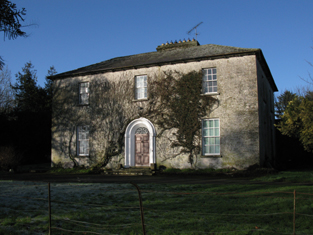
|
| Farragh | An 18th century house on the Palmer estate. Wilson refers to it as a residence of Mr. Palmer in 1786. Leased to the Waldrons in the early 19th century and occupied by Hector Sutherland at the time of Griffith's Valuation when the house was valued at almost £8. The original building is no longer extant. | |
| Woodbine | A house belonging to the Gores, Earls of Arran, which was the residence of the Ham family until the 1860s, one of whom built the Upper Bridge over the River Moy in Ballina. The Hams subleased from the Jones family. The house was bought by Anne Elizabeth Jones in the early 1870s in trust for her son Henry Hastings Jones. The Jones family sold Woodbine to an American lady in 1939. It was offered for sale again in recent years. |
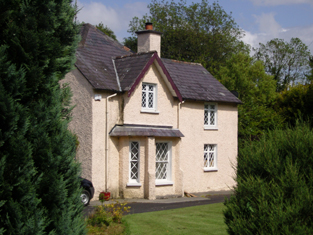
|
| Kilglass | At the time of Griffith's Valuation a house at Kilglass, barony of Tireragh, valued at £35, was being leased by Richard Verschoyle from the Ecclesiastical Commissioners. In 1906 the house at Kilglass was owned by Henry McCarrick and was valued at £37. The house appears to have been known as Kilglass Lodge at the time of the 1st Ordnance Survey. |
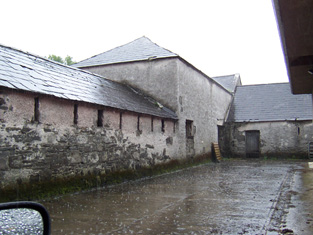
|
| Bunowna | In 1906 John L. Brinkley was the owner of a property at Bunowna, barony of Tireragh, valued at £7. At the time of Griffith's Valuation, James McMunn, MD, had been leasing this property from the Brinkley estate, when it was valued at £8. The property is labelled Bridge House on the 25-inch Ordnance Survey map of the 1890s. It is still extant. |

|
| Cooga Lodge | The house at Cooga was valued at £26 in 1906 and was the property of John Howley.At the time of Griffith's Valuation Patrick Howley had a steward's house here, valued at £4, together with 300 acres. [Grid Reference is approximate]. Local folklore suggests it afterwards became the residence of the local priest. |

|
| Kilmacurkan | In 1906 John L. Brinkley owned property valued at £20 at Kilmacurkan, barony of Tireragh. At the time of Griffith's Valuation the only building on his lands here was a herd's house valued at 5s. A substantial building is indicated on the 25-inch Ordnance Survey map of the 1890s but no trace of this remains now. Local sources indicate that this was a scutch/flax mill, of which the ruins still stand including the traces of the flax ponds, various sheds, etc that are present on the 1890 map. | |
| Seaville or Seaview House | At the time of Griffith's Valuation James Kerr was leasing a house valued at £12 at Carrownurlaur from the Wingfield estate. It is labelled Seaville House on the First Edition Ordnance Survey map but as Seaview House on the later 25-inch edition of hte 1890s. Portion of the original building remains. | |
| Rathmeel | The representatives of William Ormsby were leasing a property valued at £12 at Rathmeel, barony of Tireragh, to Augustus Bolton at the time of Griffith's Valuation. Extensive modern development has taken place in this area. | |
| Quignamanger | Charles Craig was leasing a property valued at £6 at Quigamanger, barony of Tireragh, from Edward Howley at the time of Griffith's Valuation. Since 1898 this townland has been located in county Mayo. Modern housing exists in this location now. | |
| Quignalecka | At the time of Griffith's Valuation Rev. James Lindsay was leasing a property valued at £5 at Quignalecka, to Capt. William Wright. Since 1898 this townland has been part of county Mayo. | |
| Cuffe House or Camcuil | Camcuill townland was part of Peter Niddrie's estate at the time of Griffith's Valuation. The house with highest value was that of Edward Larrinan, leasing a property valued at £3 from Peter Niddrie. McTernan states that the house had originally belonged to the Brownes and later the Jones family of Fortland. In 1874 the sale notice referring to the Niddrie estate mentions Camcuill as "a comfortable dwelling house with extensive offices, recently erected". In 1906 a house in this townland is recorded as the property of the representatives of Grace Niddrie. |
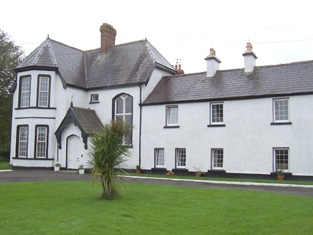
|
| Knockaculleen A | At the time of Griffith's Valuation, William Rutledge was leasing a house valued at almost £10 at Knockaculleen, barony of Tireragh, to Catherine Rutledge. [Grid reference is approximate]. | |
| Seafield | At the time of Griffith's Valuation, this property was held in fee by Robert McMunn. It consisted of a herd's house, valued at 10s and 75 acres. Later, as Seafield House, it was the residence of James McMunn,MD. In 1906 James McMunn, M.D. is recorded as the occupier of property at Killeenduff townland, barony of Tireragh, including a mansion house. Seafield was derelict for some time but has recently been restored. |
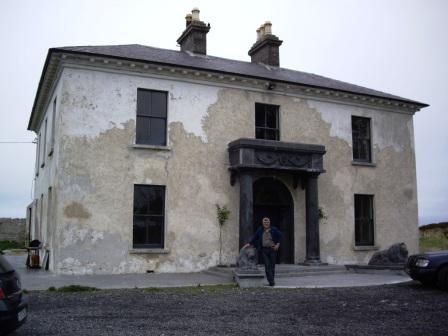
|
| Finned (Tireragh) | At the time of Griffith's Valuation, George Beatty (or Beattie) was leasing a house valued at £5 and almost 100 acres from the Tottenham estate. McTernan states that he was referred to at the time of the Ordnance Survey as a "middleman for a large amount of property". Later the house passed by marriage to the Boyd family who sold it in the early twentieth century. It is still extant and has been renovated. |

|
| Rinroe House | Rinroe was leased from the Wingfield estate by John Boyd at the time of Griffith's Valuation, when it was valued at £8. It later became a residence of the Ormsby family, relatives of the Ormsbys of Glen, and remained in that family until the 1960s. Earlier, in 1786, Wilson refers to it as "Bunro, the seat of Mr. Leech". The house is still extant. | |
| Roslea Cottage | A house built after the publication of the first Ordnance Survey map. It was leased by Hugh Kivilican from the Brinkley estate at the time of Griffith's Valuation when it was valued at £3. It is still extant though in need of restoration and in 2012 was offered for sale. |
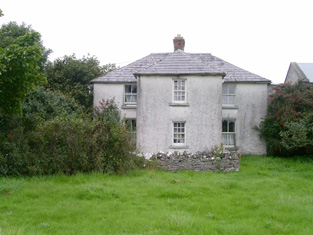
|
| The Lodge | A house with foundations dating from the 17th century, visited by Mary Delaney in the 1730s and occupied by the French in 1798. By 1837 it was the home of T. Kirkwood and, in the mid 19th century, of the Very Reverend J. Collins who held the property valued at £20 from the Ecclesiastical Commissioners. In the late 19th century this house was the home of Captain Alfred Charles Knox, a younger son of John Knox of Castlerea, Killala. Bence Jones writes that the house was enlarged circa 1820 by the addition of a bow shaped wing and that for a time it was the home of the Pery Knox Gore family. In the later 19th century the house was the home of the Timony family who owned a substantial import business in Killala. In the later 20th century owned by Lord Rathcaven and now the Irish home of Noeleen Farrell. |

|
| Rathfranpark | In 1894 Slater refers to Rathfranpark as the residence of Edmund Knox. At the time of Griffith's Valuation this townland was part of the Palmer estate and leased by Thomas Scott. The house on the property at that time was valued at almost £2. There is still a house at this site. | |
| Rathowen | In 1786 Wilson refers to a house which he calls "Rathrone", a mile and a half West of Killala, which was part of the estate of the Bishop of Killala. At that time it was occupied by James Rogers, though Wilson indicates it was the property of Rev. G. Rogers, Chancellor of Dromore. Most of the townland was in the possession of William Kirkwood, leasing from Harriett Gardiner, at the time of Griffith's Valuation. The house is no longer extant. | |
| Carnisk | John Sproule was leasing this property from Sir James Stewart's estate at the time of Griffiths Valuation in the 1850s, when it was valued at £18. This appears to be the house labelled Carnisk on the 25-inch Ordnance Survey map of the early twentieth century. An earlier house, shown on the 1st edition Ordnance Survey map, was located nearby at C209209. A large farming complex exists at the Carnisk site now. |

